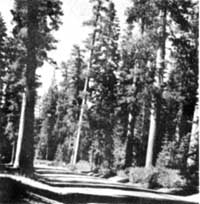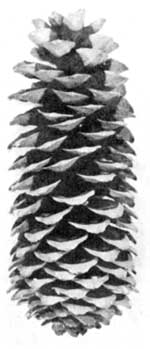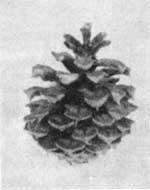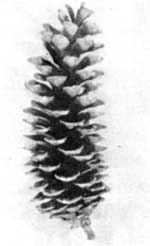|
Volume XXI - 1955
Crater Lake Pines
By Orville Page, Ranger Naturalist
Photos by C. Warren Fairbanks

Ponderosa pines near the South Entrance
From Kodachrome by C. Warren Fairbanks
|
There are many beautiful trees in Crater Lake National Park, many
virgin areas untouched by the woodsman's axe or the camper's fire.
Stately trees that have lived for centuries are here for the enjoyment
of the park visitor, trees that will remain here for generations to come
if the scourge of fire is kept out.
The pine tree has rather long, cylindrical needle-leaves that are
clustered together in little bundles and are held together by a sheath
at the base. The number of needles in the cluster is one of the
characteristics used for identification of the different types of pines.
The foliage is rather open, allowing the sun's rays to make irregular
splotches of light on the forest floor. The cones are more rough and
coarse than those of the firs and hemlocks.
Crater Lake National Park boasts five beautiful species of pines.
These trees grow throughout the area in belts, according to elevation,
which may be referred to as Life Zones. The ponderosa pine, Pinus
ponderosa Dougl., and the sugar pine, Pinus lambertiana
Dougl., are found at the lowest elevations of the park. They grow in the
Transition Zone, which runs up to about 5,500 feet elevation above sea
level at this latitude. The Canadian Zone, which here ranges between
about 5,500 and 6,200 feet, includes the lodgepole pine, Pinus
contorta Dougl. var. latifolia Engelm., and the western white
pine, Pinus monticola Dougl. The white-bark pine, Pinus
albicaulis Engelm., is found in the highest elevations of the park,
comprising the area referred to as the Hudsonian Zone. One should
realize that there is considerable overlapping of these growing areas
and that the above figures are quite general. They will vary
considerably according to local conditions of exposure, sun and
weather.

Ponderosa pine cone, x1/7
|
The beautiful ponderosa pine is the most outstanding pine of the
park. As one enters from the south, these towering trees with their
golden-brown bark, frame the roadway so magnificently that they are
sometimes mistaken for giant redwoods. If one examines the large bark
plates closely, he can readily see scales having shapes that might well
remind him of a piece of an old jigsaw puzzle. These majestic trees are
well named, these ponderous ponderosa pines.

Sugar pine cone, x1/7
|
The largest and most stately of all our pines is the sugar pine. It
is both larger and taller than its close neighbor, the ponderosa. It
received its name from the fact that, in scarred or burnt areas of its
bark, it sometimes exudes a sugary resin. This the Indians particularly
esteemed. The sugar pine is becoming quite scarce in logging regions. It
is a favorite of the lumbermen because of its enormous size and its soft
white wood. Fortunately, the trees in the park are protected from this
fate.

Lodgepole pine cone, x1/7
|
The lodgepole is probably the most abundant pine in this area. In
the southwestern part of the park it grows in dense groves. It is often
referred to as "doghair pine," because of its thick growth, and as "jack
pine." Lodgepole pine received this name because of its particular
usefulness. The Rocky Mountain Indians used these slender trees for
making their teepee poles and drag-sleds. The Plains Indians traveled
hundreds of miles to secure these poles. More recently, the pioneers
adapted this practice to the building of their cabins and lodges.

Western whie pine cone, x1/7
|
The cones are often sealed by a sticky resin which prevents release
of the seeds. They may remain dormant within the cone for decades. Since
growth is so thick, lodgepole pine forest has a high fire incidence.
When fire sweeps through such a forest, the resin of the cone is melted
and the seeds are freed to start a new grove. If fire is kept out long
enough, gradually some of the larger, more shade-loving trees will work
their way in and crowd out the slender lodgepole.
A very attractive but not so abundant tree is the western white
pine. Often one will notice a dozen or more rather long, tapering cones
near the top of this tree. If one examines the needles of the tree and
finds them in bundles of five, he is readily assured of its identity as
a white pine.

Whitebark pine cone, x1/7
|
The most beautiful, in a grotesque sort of way, is the white bark
pine. The odd shapes of these trees are the result of exposure to the
icy winds and winter snows at high elevations. Because of the severe
weather it endures, this pine may be rather bushy and only three or four
feet high, even though it is many decades old. It is often found growing
in a crevice on some rocky ledge where it would appear that no tree
would be able to survive. The seeds of its small purple cone are
especially favored by nutcrackers and chipmunks.
These trees provide homes and food for many of the forest animals.
These beautiful homes, centuries old, can be destroyed in a matter of
minutes by someone's carelessness. Let's protect our trees and keep our
parks and forests green.
Comparative Table of the Pines of Crater Lake
National Park
| Name |
Mature Size
Height;
diameter |
Mature Bark |
Cone
Length;
width |
Needles
Length;
number |
Ponderosa pine
Pinus ponderosa |
60-125 ft.
2-2.5 ft. | Large golden-brown plates |
3-6 in.
2-4 in. | 5-11 in.
3/bundle |
|
Sugar pine
Pinus lambertania |
70-150 ft.
3-6 ft. | Long plates; reddish brown to grayish brown |
10-20 in.
2.5-3.5 in. | 2.5-4 in.
5/bundle |
|
Lodgepole pine
Pinus contorta var. latifolia |
30-50 ft.
2-6 in. | Thin; silver-gray to black | 1-2 in.
.75-1.5 in. |
2 in.
2/bundle |
|
Western white pine
Pinus monticola |
50-100 ft.
1-3 ft. | Small plates; silver-gray | 6-10 in.
2-3 in. |
2-4 in.
5/bundle |
|
White-bark pine
Pinus albicaulis | 6-60 ft.
1-5 ft. |
Thin; silver-gray to white | 1-3 in.
.75-2 in.
purplish |
1-2.5 in.
5/bundle |
|
References
Farner, Donald S. 1952. The Birds of Crater Lake National
Park. Lawrence, University of Kansas Press. xi, 187 pp.
McMinn, Howard E., and Evelyn Maino. 1946. An Illustrated Manual
of Pacific Coast Trees. Berkeley, University of California Press.
xii, 409 pp.
Peattie, Donald C. 1953. A Natural History of Western Trees.
Boston, Houghton Mifflin Company. xiv, 751 pp.
Sudworth, George B. 1908. Forest Trees of the Pacific Slope.
Washington, D. C., Government Printing Office. 441 pp.
Charcoal Log Reidentified
By Richard M. Brown, Assistant Park Naturalist
The large section of a charcoal log which is now exhibited in the
Information Building is apparently (Libbey, 1956) the same one as that
which has previously (Anonymous, 1931:1) been referred to sugar pine
(Pinus lambertiana Dougl.). Recent examination of material from
this log has led Prof. D. W. Bensend (1956), Department of Forestry,
Iowa State College, Ames, Iowa, to state that "one can say with a fair
degree of certainty that it was ponderosa pine."
This identification, as well as the earlier one, is in line with the
summary which Williams (1942:113) has provided of the species
represented by various pieces of charred wood collected in the immediate
vicinity of Mt. Mazama. Appreciation is expressed to Dr. Bensend for
this contribution to our information concerning the natural history of
the Crater Lake area.
Literature Cited
Anonymous. 1931. Another page from the past discovered. Nature
Notes from Crater Lake 4(2): 1- 2.
Bensend, D. W. 1956 (February 10). Letter in files of Park
Naturalist, Crater Lake National Park, Oregon.
Libbey, D. S. 1956 (May 1). Personal communication.
Williams, Howell 1942. The Geology of Crater Lake National Park,
Oregon. Carnegie Institution of Washington Publication 540.
Washington, D. C., Carnegie Institution of Washington. vi, 162 pp.
|

